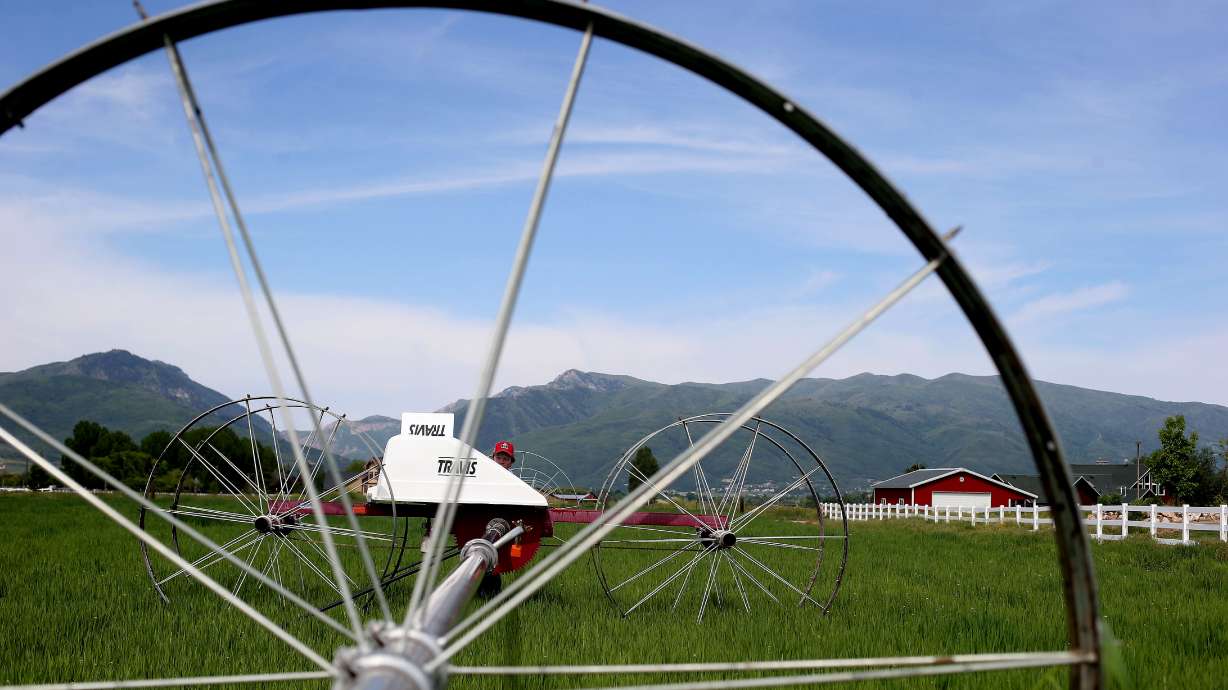Estimated read time: 4-5 minutes
This archived news story is available only for your personal, non-commercial use. Information in the story may be outdated or superseded by additional information. Reading or replaying the story in its archived form does not constitute a republication of the story.
SALT LAKE CITY — Gov. Spencer Cox this week issued an executive order regarding when state facilities can water lawns.
It's the latest water conservation provision issued by the state amid Utah's ongoing drought. As state and local officials look for ways to conserve Utah's water supply, the Utah Department of Agriculture and Food announced Wednesday that it had started enrollment for a program that helps farmers and ranchers pay for new technology that allows them to reduce water consumption.
The Water Optimization Program actually began in 2018 after the state Legislature passed a bill that year that provided about $1.2 million in funds as a way to reduce water consumption. The program was successful enough and nearly all of the original funds were used up by eager farmers and ranchers seeking to update their equipment but who were otherwise unable to pay for it, said Craig Buttars, commissioner of the Utah Department of Agriculture and Food.
"The purpose of the program is to reduce consumptive water use while still maintaining or improving agriculture production and profitability," he explained. "So it's a conservation program, but it helps farmers to be able to significantly reduce the water usage while increasing crop yields."
The first round of funding through that 2018 bill ultimately saved the state about 9.1 billion gallons of water, Buttars added. Its success and the ongoing drought concerns are why the state Legislature approved $3 million in new funding during this year's legislative session.
According to the agency's website, the new round of enrollment allows upward of 50% of the cost of an irrigation overhaul with a cap of $250,000 from the state. All projects must fit the criteria outlined on the website, and a committee will review applications and rank all projects to ensure the ones that fit the intent of the program are funded first.
Utah farmers and ranchers can apply through the department website. They have until July 2 to submit their applications.
"Cost is sometimes a huge barrier to these improvements and the Water Optimization Program goes a long way to helping producers upgrade their irrigation systems," Butters said, adding that he recently spoke with a farmer in the Vernal area that used the program and found they could produce the same crop yield with 20% less water.
Its extension comes as farmers and ranchers are expected to deal with some of the worst drought conditions the state has ever seen. The U.S. Drought Monitor lists 90% of Utah in at least an "extreme" drought, with more than half of the state in an "exceptional" drought, which has been the case for months.
Related:
A little more than 80% of all water consumption in Utah goes toward agriculture, the state reported in 2019. As Buttars points out, that's because it takes water to ensure that animals and plants live.
"It takes water to put food on the table, and this is where it's used and where it's consumed — it's in our agricultural operations," he said.
Even before Cox issued an emergency declaration over the drought in March, Brian Johnson, a rancher in Tooele County, told KSL TV that the conditions were "very challenging."
"We're used to dry conditions. We do live in the desert but, as it gets drier and drier over the past few years, it starts taking a toll on us," he said, back in February.
Butters said this year's agriculture season is indeed shaping up to be "pretty bleak." Barring a sudden change or rain, many irrigation systems will likely need to be shut off earlier in the year than usual.
Unless there's the right amount of rain at the right time, it also means a lower yield for farmers. He explained that if a farmer normally gets three or four cuttings of their alfalfa crop, they may wind up with one or two this year.
"There are some areas of the state that could go without water the whole season, especially in the southern part of the state," he added. "The streams are usually running quite high at this time. We're seeing the lowest runoff that we've ever seen in a lot of these streams. It doesn't look good at all. … This year, there's a lot of places that won't even have water."
The current conditions are why he said the expansion of the Water Optimization Program was important.
It's an improvement not just for 2021 but for years to come because agricultural water saved from less demand means more water saved for however long the drought lasts. That's critical because nobody can predict when it will end.
That's why Buttars said water conservation techniques are important even if you aren't a farmer or rancher.
"That's something we all should participate in," he said.










